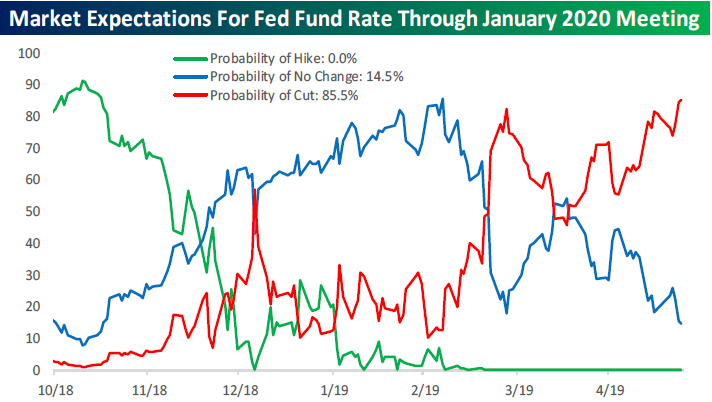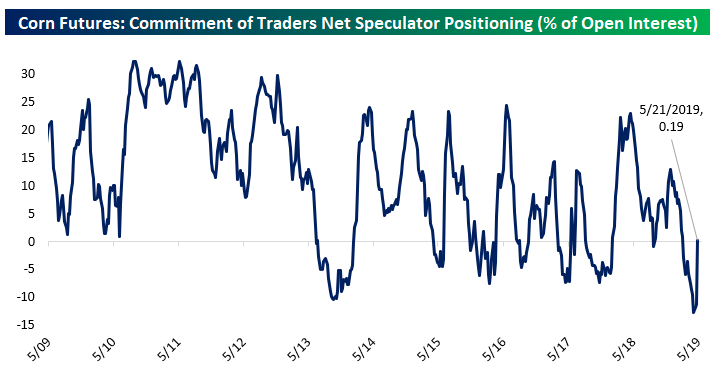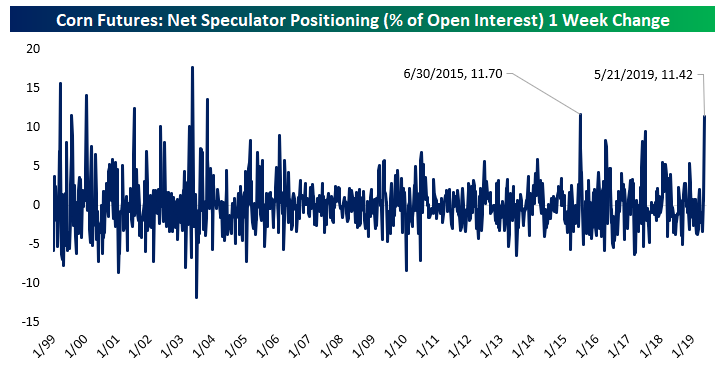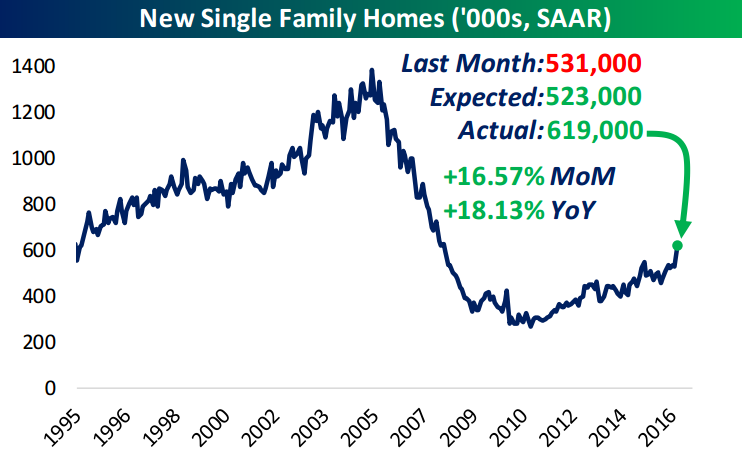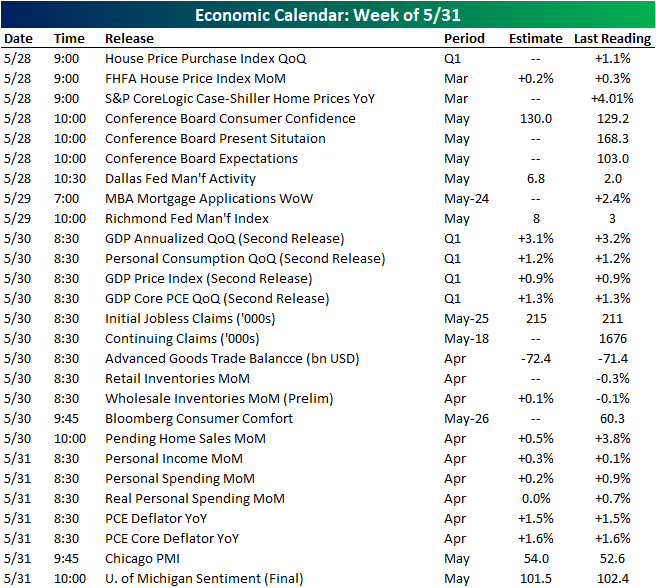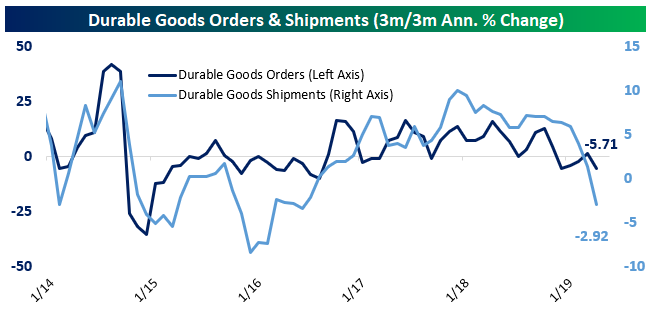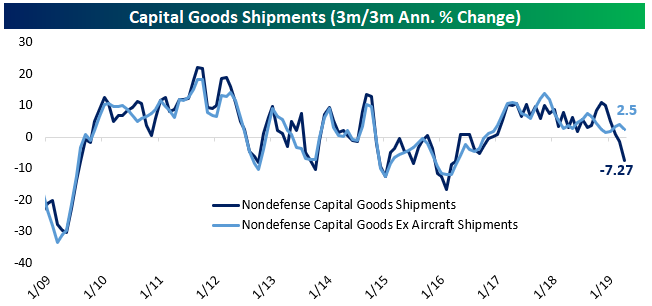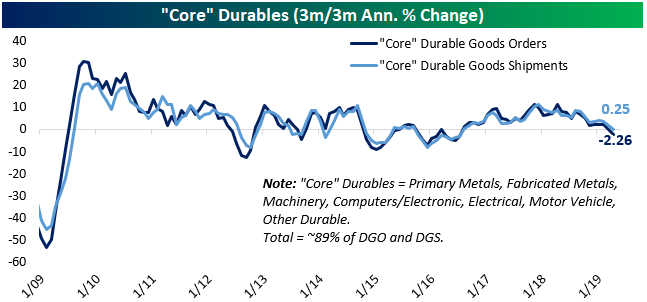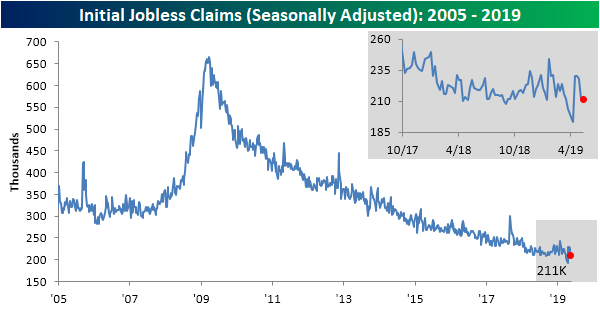Morning Lineup – Easing in to a New Week
Welcome back from the long weekend. It’s looking like a modestly positive start to the trading week as US futures have been drifting higher as we head into the open, and after every Monday so far in May has been a weak one, bulls can be thankful that this week starts off with a Tuesday instead!
Looking ahead to today, Consumer Confidence for May will be released at 10 AM and the Dallas Fed Manufacturing report will come out a half hour later.
Make sure to check out today’s Morning Lineup for recap this weekend’s EU elections and the latest confidence readings for the region.
After failing to convincingly break out to new highs in April, the latest pullback for the S&P 500 brought the index right down to an important support level, which held for the time being. As shown in the chart below, last week’s pullback is now the second time that the index has tested that support in the last two weeks. This is an important level to watch in the days ahead, as the more often support gets tested the weaker it becomes.

Start a two-week free trial to Bespoke Premium to see today’s full Morning Lineup report. You’ll receive it in your inbox each morning an hour before the open to get your trading day started.
Bespoke Brunch Reads: 5/26/19
Welcome to Bespoke Brunch Reads — a linkfest of the favorite things we read over the past week. The links are mostly market related, but there are some other interesting subjects covered as well. We hope you enjoy the food for thought as a supplement to the research we provide you during the week.
While you’re here, join Bespoke Premium for 3 months for just $95 with our 2019 Annual Outlook special offer.
Assessing Achievement
IQ rates are dropping in many developed countries and that doesn’t bode well for humanity by Evan Horowitz (NBC)
IQ test results are starting to slide in a variety of developed countries, suggesting that the world is getting dumber, posing concerns about the ability to innovate…though interestingly American results buck that trend. [Link]
Many More Students, Especially the Affluent, Get Extra Time to Take the SAT by Douglas Belkin, Jennifer Levitz and Melissa Korn (WSJ)
An increasing number of students are getting extra time to take the SAT, and the doctors notes which allow for that advantage are easier to come by for the affluent. [Link; paywall]
What the Childhood Years of Tiger Woods and Roger Federer Can Teach Us About Success by David Epstein (Sports Illustrated)
An instructive comparison of two sports stars who took a completely opposite approach to early sports, yet both ended up at the absolute pinnacle of success. [Link]
The Peculiar Blindness of Experts by David Epstein (The Atlantic)
An obscure bet between a Malthusian scientist and a more hopeful economist offers a lens into the sometimes perverse incentives and frictions which have made long-term forecasting so unreliable in recent decades. [Link]
Tariff Trouble
New China Tariffs Increase Costs to U.S. Households by Mary Amiti, Stephen J. Redding, and David E. Weinstein (NYFed)
Previous research suggested that the average US household paid $414 more for goods based on 2018 tariff levels. The newest 15% tariff rate on $200bn of goods adds $831 to consumers’ costs, and notably the deadweight loss goes from 32% to 75% of the total tariff costs. [Link]
The US tariffs on China have been paid almost entirely by US importers: IMF study by Fred Imbert (CNBC)
An IMF study was also released this week suggesting that consumers have “borne almost entirely” the costs of tariffs levied by the Trump Administration. [Link]
Health Care
CVS to test unregulated vitamins and dietary supplements by Shamard Charles (NBC)
As a condition of stocking unregulated supplements, CVS will start requiring independent testing to make sure that what it sells to consumers will be what is advertised. [Link]
End-to-end lung cancer screening with three-dimensional deep learning on low-dose chest computed tomography by Diego Ardila, Atilla P. Kiraly, Sujeeth Bharadwaj, Bokyung Choi, Joshua J. Reicher, Lily Peng, Daniel Tse, Mozziyar Etemadi, Wenxing Ye, Greg Corrado, David P. Naidich, and Shravya Shetty (Nature)
Lung cancer screening that catches the disease early can lead to drastically lower mortality, so offering it at lower prices could have a major impact by broadening access. This paper demonstrates a deep learning technique that achieves a 94% success rate diagnosing lung cancer, offering a hope for cheaper access. [Link]
Climate Change
Geophysical constraints on the reliability of solar and wind power in the United States by Matthew R. Shaner, Steven J. Davis, Nathan S. Lewis, and Ken Caldeira (Royal Society of Chemistry)
Using 30+ years of data on weather and temperature patterns, the authors illustrate the physical constraints on operating a power grid exclusively on solar and wind technology, assuming no large-scale storage capable of matching electrical generation timing to demand timing. [Link]
Nudging out support for a carbon tax by David Hagmann, Emily H. Ho, and George Lowenstein (Nature)
The authors show that “nudge” efforts to reduce climate impact (fly less, reduce electricity or plastic consumption, etc) reduce support for larger climate change action because they are perceived as a burden. [Link]
Social Media
CrossFit, Inc. Suspends Use Of Facebook And Associated Properties (CrossFit)
After a large diet information sharing group was deleted by Facebook, CrossFit is abandoning the platform and all its properties. [Link]
Tech Dystopia
It’s Getting Way Too Easy to Create Fake Videos of People’s Faces by Samantha Cole (Vice)
Neural networks and other “AI” techniques are getting easier and easier to operate, leading to the possibility that video can be easily faked in order to deceive. [Link]
Hackers have been holding the city of Baltimore’s computers hostage for 2 weeks by Emily Stewart (Vox)
Hackers have taken control of computer networks operated by the city government, demanding about $100,000 in bitcoin to unlock them. [Link]
Tech Utopia
Driverless Cars Working Together Can Speed Up Traffic By 35% by Saravana (Gimate)
A new University of Cambridge study has shown that coordinated driverless cars could increase traffic volumes by 35% or more. [Link]
Personal Finance
Broke Millennials Are Flocking to Financial Guru Dave Ramsey. Is His Advice Any Good? by Kristen Bahler (Yahoo!/Money)
An evangelical radio host from Tennessee is offering tough love and uncompromising anti-debt messages to millions via the 15 hours per week he blasts from radios around the country. [Link]
Read Bespoke’s most actionable market research by joining Bespoke Premium today! Get started here.
Have a great weekend!
The Bespoke Report – It’s All Relative
Hut, Hut, Cut! With weaker economic data to contend with this week on both a domestic and international basis, plus escalating tensions between the US and China, investors are increasingly pricing in a higher likelihood of rate cuts from the FOMC before the year is out. Through mid-day Friday, the Fed Fund futures market was pricing in over an 85% chance of a rate cut between now and the January 2020 meeting. Those are the kind of odds that would make James Holzhauer say “All in.”
This week’s Bespoke Report newsletter is now available for members. In this week’s report, we cover all the bases including the massive declines in semis, one of the shallowest five-week losing streaks for the DJIA on record, the shift to defensives, the disconnect between the market and the Fed, the widening gap between Internationals and Domestics, summer seasonality, sentiment updates, what the S&P 500’s flat 200-DMA means for equities, big gaps down on a daily basis, and more.
We cover everything you need to know as an investor in our weekly newsletter. To read the Bespoke Report and access everything else Bespoke’s research platform has to offer, start a two-week free trial to one of our three membership levels. You won’t be disappointed!
Corn Stop Out-Pocalypse
Earlier this week we discussed the very poor condition of the corn crop’s spring planting. Apparently, corn speculators are taking the data to heart. The chart below shows the percentage of outstanding open interest that represents the number of contracts speculators hold long net of their short positions. This data is released weekly in the CFTC’s Commitment of Traders report. As shown, corn speculators have abruptly about-faced from a historically large short position to a very small long. Start a two-week free trial to Bespoke Institutional to track futures positioning across asset classes.
The change has been one of the largest in the last 20 years, equivalent to 11.4% of open interest. In other words, as corn prices have surged, positioning has been cleared out. That could be a good sign for where prices head next if you assume that speculators are going to keep pushing contracts higher by building longs. On the other hand, with positioning now cleaned out, the contrarian view is that markets are vulnerable to bearish moves now without large and vulnerable shorts that are sensitive to price moves higher.
The Closer: End of Week Charts — 5/24/19
Looking for deeper insight on global markets and economics? In tonight’s Closer sent to Bespoke clients, we recap weekly price action in major asset classes, update economic surprise index data for major economies, chart the weekly Commitment of Traders report from the CFTC, and provide our normal nightly update on ETF performance, volume and price movers, and the Bespoke Market Timing Model. We also take a look at the trend in various developed market FX markets.
The Closer is one of our most popular reports, and you can sign up for a free trial below to see it!
See tonight’s Closer by starting a two-week free trial to Bespoke Institutional now!
Next Week’s Economic Indicators – 5/24/19
Despite a light data slate, there were not too many bright spots this week as only four of the fourteen releases showed improvements from the prior period or beat estimates; the rest came in weaker or missed forecasts. The Chicago Fed’s National Activity Index was the only release on Monday coming in weaker than both March’s reading and consensus estimates. Similarly, April Existing Home Sales was the only release Tuesday, and results were once again weaker than expected. While Initial Jobless Claims on Thursday were better than expected, Continuing Claims missed by 10K. Flash PMIs were very weak for both manufacturing and the services sectors. Friday morning, advanced manufacturing orders, sales, and inventories all disappointed (we covered in an earlier post). Start a two-week free trial to Bespoke Institutional to access our interactive economic indicators monitor and much more.
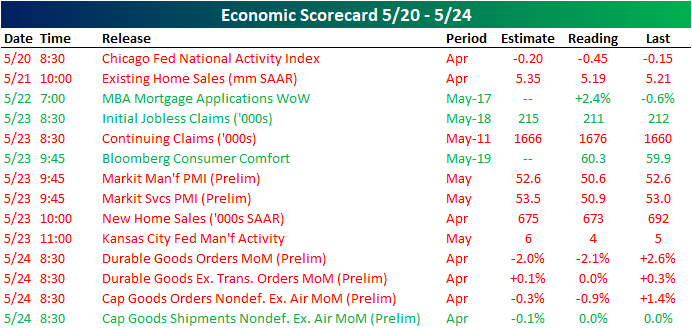
Activity picks back up next week with 27 releases on the docket. Due to Memorial Day holiday, markets will be closed, and no data is to be released on Monday. But on Tuesday things pick back up with multiple home price indices. The quarterly House Price Purchase Index for Q1 will come out in addition to the FHFA House Price Index and S&P CoreLogic Case-Shiller Index for March. More housing data will be out on Thursday with Pending Home Sales. The Conference Board’s Consumer Confidence for May and the Dallas Fed’s Manufacturing Activity Index will also be released Tuesday, and both are expected to show an increase. The Richmond Fed will follow that up with their own manufacturing index on Wednesday, similarly expected to increase relative to April. In addition to the typical weekly data on Thursday, the second release of Q1 GDP will be out. While consumption and inflation are expected to be unchanged from the initial release, GDP is expected to be 0.1% weaker. Personal Income and Spending for April is due out in what will be a busy Friday. While income is expecting an uptick, spending data is forecasted to be considerably weaker. The Fed’s favored inflation gauge, PCE, along with the Chicago PMI and University of Michigan Sentiment will round out the week on Friday.
Durable Goods Sucking Wind
This morning’s advance report on April manufacturing new orders, sales, and inventories was a pretty notable disappointment. The advance report only provides data on durable goods industries, which are revised at a two week lag when numbers for nondurable industries are added too. In addition to missing expected MoM changes (which were already pretty modest), the report saw downgrades to March as well. We tend to be careful about reading too much into MoM numbers in the report due to its volatility and high level of revisions. In the chart below we show the rolling 3 month average for durable goods orders and shipments relative to the prior 3 months’ average level, annualized. As shown, shipments are really diving, while new orders are of course falling too. Start a two-week free trial to Bespoke Institutional to access our interactive economic indicators monitor and much more.
One indicator within the report that gets a lot of attention is the “core capex” proxy. This number tracks sales (shipments) of non-defense capital goods, which is a good proxy for how much businesses are spending on equipment capital expenditures. As shown, aircraft shipments have slowed sharply, changing things from bad to worse relative to ex-aircraft numbers. Those are still growing, but relatively slowly.
We also like to strip out the most volatile components of durable goods. These aren’t capital goods only (like the above series), but we do strip out the most volatile categories of durables. As shown, this measure’s orders number is now down 2.2% annualized on a 3m/3m basis, the lowest since 2016, and shipments (which are included in GDP calculations, unlike new orders) are only barely positive.
Finally, and arguably most concerning, is that over the last few months inventories have started to pile up rapidly. As shown in the chart below, inventory-sales ratios have been climbing for some time, but the uptick has been especially dramatic in the last 2 to 3 months after revisions released today. Both are now firmly above the 2010-Current average for these numbers and represent excess production relative to demand; that’s a bad sign for the outlook in the manufacturing sector.
Technology vs. Utilities
Below are relative strength charts (vs. the S&P 500) for the Technology and Utilities sectors. In the chart, when the line is rising, the sector is outperforming the S&P 500, and vice versa for a falling line. In each chart we provide dots for days that the FOMC made a rate decision. Blue dots are days when the Fed left rates unchanged, while red dots are days when the Fed hiked rates.
While the Fed kept rates unchanged at its most recent meeting, it marked a key turning point for the cyclical Tech sector and the defensive Utilities sector. Since the last FOMC meeting, Tech has seen its relative strength plummet as investors have shifted quite dramatically into defensives like Utilities.
The rally for Utilities and decline for Technology have done a number on valuations for the two sectors, to the point where their trailing 12-month P/E ratios are nearly the same. Tech’s P/E currently stands at 20.52, well below the reading near 24 it had in late 2018. Utilities has seen its P/E balloon above 20 up to 20.10 as of this morning, which is nearly 5 points higher than it was at the end of 2018. When a no-growth sector like Utilities has a P/E that’s similar to a growth-oriented sector like Tech, it doesn’t say much about the confidence of investors.
Morning Lineup – 90 Up, 184 To Go
This just hasn’t been a month for months or Prime Ministers with the name May. This May, stock markets around the world are on pace for their worst month of the year, and this morning UK Prime Minister Theresa May has finally given in and announced her resignation effective June 7th. Thankfully, June is right around the corner. While it’s been a pretty bad May, US equities are doing their best this morning to finish off the week on a positive note as Dow futures are indicating a positive open of +90 points (down from earlier highs) which would mean that it only needs another 184 points to get back to even for the week. While it’s a full day of trading, with the holiday weekend coming up, you can bet that a lot of trading desks will start to clear out early today.
Make sure to check out today’s Morning Lineup for a recap of all the important overnight and morning events from around the world. Included in today’s report is our take on Theresa May’s resignation, as well as an analysis of the short-term trading action in European equities.
You don’t need us to tell you that investors have been rotating into defensive sectors lately, but we have a great illustration of it for you. The chart below shows the relative strength of the S&P 500 Technology sector and compares it to the relative strength of defensive sectors like Utilities, Consumer Staples, and Health Care. In the chart, rising lines indicate periods where the sector outperformed the S&P 500 and vice versa.
For much of 2019, Technology was leading the market higher, while all three defensive sectors lagged. In late April, though, it was like a switch went off as trade war fears intensified. Investors quickly started rotating out of Technology and into the defensives, which have surged relative to the market.

Start a two-week free trial to Bespoke Premium to see today’s full Morning Lineup report. You’ll receive it in your inbox each morning an hour before the open to get your trading day started.
B.I.G. Tips – Stocks With International Exposure Crushed
We’ve just published a B.I.G. Tips report that provides a glance at the disparity between US stocks with and without heavy international exposure.
Headlines covering the ongoing trade dispute remain a leading catalyst for market action this month. Given the ramping up of these concerns, it can be reasoned that domestics would begin to outperform internationals, and so far, we have seen exactly this. To evaluate, we break up the S&P 500 into deciles based on international revenue exposure. We also show a decile analysis for May performance based on dividend yield and YTD change through April in addition to the best and worst performing stocks in May. To read this report and access all of our other reports, start a two-week free trial to Bespoke Premium!

